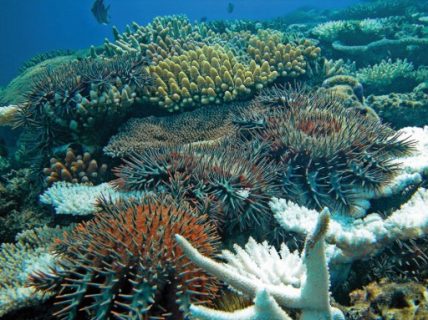
by Richard Ingham
PARIS, France (AFP) — The beast goes by the Latin monicker of Acanthaster planci, but it is known to us as the crown-of-thorns — a venomous starfish that is ravaging our precious coral reefs.
One of many threats to coral, the large, spine-studded species is capable of chewing through kilometers (miles) of reefs when large numbers of it gather and spawn.
In desperation, guardians of reefs in the Indian Ocean and Pacific hire divers to remove the starfish physically or inject it with a lethal poison that does not harm other species.
But science has now opened up a new front in the offensive — a genomic map which one day may lead to bio-compounds designed to lure starfish to their doom.
In a study published in the journal Nature on Wednesday, an Australian-led team describe how they unravelled the DNA code of the crown-of-thorns.
They used this knowledge to identify a constellation of genes used by the starfish to communicate through biochemicals in the water — a potential chink in its spiny armor.
Experiments in a lab-tank maze showed that the starfish responded dramatically to plumes of proteins released by fellow members of its species that cause the creatures to gather for spawning, a process called aggregation.
Conversely, the starfish fled when exposed to proteins released from its major predator, the giant triton snail (Charonia tritonis).
When the water was analyzed, the scientists identified around 400 proteins that had been secreted by the starfish during the stimuli, including enzymes and signalling proteins.
The research is led by Michael Hall of the Australian Institute of Marine Science in Queensland.
The work could open the way to smart biochemical mimickry, said Monica Medina, a biologist at Pennsylvania State University.
Safe compounds that imitate these starfish proteins could be used as a lure, she said in a commentary also published by Nature.
“As large groups of individuals are induced to aggregate, underwater robots specifically created for lethal injections of (crowns-of-thorns) could then be deployed across vast outbreak areas, replacing the human drivers who currently perform this procedure,” Medina said.
“(…) Containing (crown-of-thorns) outbreaks suddenly seems a more attainable goal, at both regional and global scales.”
Killer outbreaks
In small numbers, the crown-of-thorns is not a threat.
Indeed, it even plays a vital ecological role because it feeds on the fastest-growing corals, which enables slower-growing corals to form colonies.
The problem arises when the starfish population surges to plague levels, potentially inflicting even worse damage than coral bleaching and disease.
The trigger for these outbreaks is unclear.
Mooted causes include a sudden increase in nutrients and pollutants, provided by a runoff of water from the land, or a spike in sea temperature.
On Australia’s Great Barrier Reef, the first documented crown-of-thorns outbreaks was in 1962, followed by others that ran from 1978 to 1991, from 1993 to 2005 and an episode that began in 2010 and continues today.
Previous research by the Australian Institute of Marine Science found that coral cover on reefs that it surveyed had fallen by about 50 percent over the past 30 years.
The crown-of-thorns was responsible for almost half of this decline. Without outbreaks of the predators, there would have been a net increase in coral cover.







